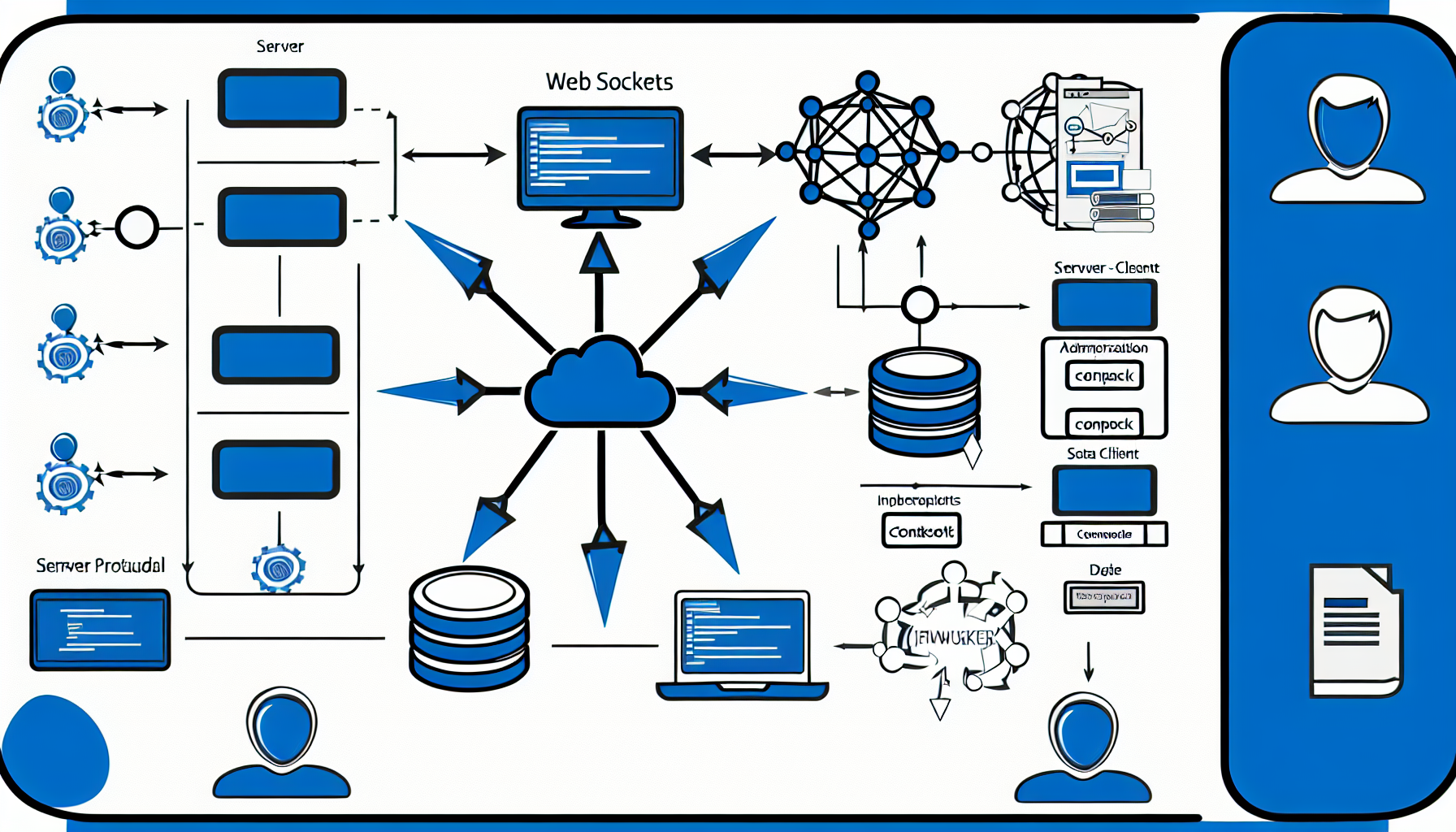Enhance user experience with real-time communication using WebSockets and server-sent events. Learn how to implement these technologies for better interaction on your website.

Real-time communication (RTC) has become an essential component of modern applications, significantly influencing how users interact with digital systems. By enabling instantaneous data transfer, RTC enhances user experiences across a wide range of platforms, from social media and online gaming to financial services and collaborative tools. Users today expect applications to be responsive, providing up-to-date information without delay. This expectation is met through technologies such as websockets and server-sent events (SSE), which facilitate seamless and efficient client-server interactions.
Websockets represent a protocol providing full-duplex communication channels over a single TCP connection. This allows for continuous data exchange without the overhead of HTTP requests, making it particularly useful for applications requiring real-time updates, such as chat applications and live sports updates. Unlike traditional HTTP communication that follows a request-response model, websockets maintain an open connection, allowing data to flow freely in both directions. This leads to reduced latency and enhanced performance in interactive scenarios.
On the other hand, server-sent events are designed for one-way communication from the server to the client. This technology allows servers to push real-time updates to the client as events occur, making it ideal for applications that require frequent updates without the need for bidirectional interaction. Use cases for server-sent events include live feeds, stock price updates, and notifications. While SSE is simpler and easier to implement for specific use cases, it lacks the bi-directional capabilities that websockets offer.
Understanding the capabilities and applications of these technologies is crucial for developers aiming to create engaging and responsive applications. By leveraging websockets and server-sent events, developers can offer users seamless communication experiences, thus enhancing the overall functionality and appeal of their digital products.

Websockets represent a significant advancement in web communication technology, providing a bi-directional communication channel that allows for real-time interactions between clients and servers. Unlike traditional HTTP requests, which require a new connection to be established for each exchange, websockets maintain a persistent connection over a single Transmission Control Protocol (TCP) channel. This persistent connection enables both the client and server to send and receive data asynchronously, without the need for repeated handshakes. This characteristic significantly reduces latency and enhances responsiveness for applications that rely on real-time data transmission.
The establishment of a websocket connection initiates with a handshake using the HTTP protocol, wherein the client requests an upgrade to a websocket connection. Once the server confirms this request, a full-duplex communication channel is established. This means that both parties can send messages independently, allowing for a concurrent flow of information. Such functionality is particularly beneficial for applications like online gaming, chat applications, and live sports updates, where timely data exchange is critical.
In terms of performance, websockets offer several advantages. They substantially lower the overhead associated with establishing connections and transmitting data, as they do not require the browser to send repetitive headers or establish new connections for every message. Moreover, the binary framing used by websockets allows for more efficient data transfer, which is especially useful for payloads that involve multimedia or complex data structures. Additionally, websockets enable instant updates, which help create a seamless user experience by providing real-time information without noticeable delays. Overall, the adoption of websockets in web applications marks a crucial shift towards more interactive and responsive user interfaces.
Server-Sent Events (SSE) is a technology that enables a server to push real-time updates to web clients. Unlike Websockets, which allow for two-way communication, SSE is designed primarily for unidirectional streams, where data flows from the server to the client. This makes SSE particularly suitable for applications where the server frequently sends updates to the client without requiring a response for each message. The core functionality of SSE is to create a persistent connection that allows the server to push new information to the client as it becomes available.
SSE employs standard HTTP protocols, making it easier to implement and more compatible with various servers and clients. When a browser establishes a connection to a server using SSE, it maintains an open HTTP connection. This connection can continuously send new messages, which the browser processes automatically as events. This streamlined approach contrasts with traditional polling methods, where the client had to repeatedly request updates, potentially leading to increased network traffic and latency.
Use cases for Server-Sent Events are particularly prominent in situations involving live updates, such as news feeds, stock price updates, or social media notifications. For instance, a stock trading platform could utilize SSE to push real-time stock prices to users, ensuring they receive immediate information without additional requests. Similarly, an online news site might use SSE to provide live updates on developing stories, enhancing user engagement with up-to-the-minute information. As a result, SSE offers an efficient solution for applications that require real-time data streaming from the server to the client without the overhead associated with full-duplex communication channels like Websockets.
Websockets and Server-Sent Events (SSE) are both critical technologies in the realm of real-time communication, yet they serve distinct purposes and cater to different requirements. One of the most significant differences lies in their communication models. Websockets are designed for bi-directional communication, allowing both the client and server to send messages at any time. This feature makes websocket connections ideal for applications such as online gaming, collaborative tools, and chat applications, wherein timely updates from both ends are crucial.
Contrastingly, Server-Sent Events are primarily unidirectional, allowing data to flow only from the server to the client. This one-way communication model proves beneficial for scenarios like live news feeds, stock tickers, and real-time notifications, where the server updates the client with new information but does not require instant replies. Understanding these functional attributes is vital when determining the appropriate technology for a specific use case.
Performance characteristics vary significantly between the two. Websockets generally establish a persistent connection, enabling low-latency interactions and reducing overhead by allowing multiple messages to be sent without repeatedly opening and closing connections. However, this is balanced by the additional complexity involved in managing such connections. On the other hand, Server-Sent Events simplify server implementation, as they benefit from HTTP protocols, making them easier to integrate into existing web infrastructures. However, they may face limitations such as connection restrictions on server capabilities and reduced performance in scenarios demanding multiple simultaneous connections.
In summary, the choice between websockets and Server-Sent Events should be dictated by the requirements of the application being developed. Understanding factors such as communication direction, use cases, and performance characteristics will notably empower developers to make informed technology decisions that best meet their real-time communication needs.
Event-driven architecture (EDA) represents a design paradigm in which the flow of information is triggered by the occurrence of events. It is particularly significant in the context of real-time communication protocols such as Websockets and Server-Sent Events (SSE). In an EDA, components of a system communicate with each other through the exchange of discrete events, allowing for a more dynamic and flexible workflow as opposed to traditional request-response models. With this architecture, applications can react to changes as they happen, enhancing user experiences in real-time communication scenarios.
The core principle behind event-driven architecture involves the production, detection, consumption, and reaction to events. In a typical scenario, an event generator (like a user interaction or a message service) emits an event which is then captured by a listener (or consumer) to execute predefined functions. This asynchronous communication model not only decouples components, allowing for independent scalability, but also improves performance since components no longer need to send explicit requests to one another, which is crucial for applications that require rapid data exchange.
Adopting an event-driven model facilitates improved scalability and responsiveness. As the system grows, it can accommodate additional event producers and consumers without a major overhaul of the existing architecture. Moreover, it fosters a more responsive user experience, as users receive real-time updates without noticeable delays. Common design patterns in EDA include the Publish-Subscribe pattern, where events are published without knowledge of subscribers, and the Event Sourcing pattern, which focuses on capturing the state of an application as a sequence of events. These patterns further highlight the strengths of event-driven architecture, making it an ideal choice for modern applications in need of efficient real-time communication.

Implementing websockets in your project can greatly enhance real-time communication capabilities, allowing for efficient, bidirectional data exchange between the server and client. To begin, it is essential to set up a websocket server. In typical scenarios, this can be accomplished using frameworks such as Node.js with the ‘ws’ library, enabling straightforward websocket server creation.
First, ensure that you have Node.js installed, and then create a new directory for your project. Within this directory, run npm init -y to initialize a new npm project and install the websocket library using npm install ws. This installation provides the necessary tools to build your websocket server. Next, create a new JavaScript file, perhaps named server.js, and import the ‘ws’ library to set up a server that listens to incoming websocket connections.
After establishing the server, the next step is to manage client connections. By using the wss.on('connection', ...) event, your server can respond to new connections and begin to handle incoming messages. You can send and receive messages by utilizing the ws.send(data) function on the server or its corresponding client handler on the client side. This two-way communication setup is key to any effective websocket integration.
Handling message exchanges efficiently is crucial for performance optimization. To achieve this, you can implement a simple message routing system that processes different message types, allowing for priority management and enhanced data consistency. When designing your websocket logic, consider adding error handling mechanisms to ensure that any connection issues are captured and dealt with promptly. This practice will provide a smoother user experience and mitigate disruptions.
In summary, implementing websockets involves setting up a websocket server, managing client connections, and ensuring robust message handling. By following these steps and best practices, you can effectively enhance your application’s real-time communication capabilities.
Server-Sent Events (SSE) offer a robust solution for real-time communication in web applications, allowing servers to push updates to clients efficiently. To implement SSE, the first step involves establishing an SSE connection from the client-side. This can be achieved using the EventSource interface in JavaScript, which facilitates receiving a stream of updates from the server. The client initiates the connection by specifying the URL endpoint that the server will use to send events. A typical implementation would look like this:
const eventSource = new EventSource('/path-to-sse-endpoint');Once the connection is established, the server begins to send messages formatted in a specific manner. Each message contains the event type and data, and must adhere to the requirements laid out in the SSE protocol. For example:
res.write('data: Your message here\n\n');On the client-side, developers can listen for messages sent from the server using event listeners on the EventSource instance. For instance:
eventSource.onmessage = function(event) { console.log("New message: ", event.data);};Handling updates effectively is crucial for seamless user experience. It allows applications to update UI components or application states immediately upon receiving new data. SSE is particularly well-suited for applications that require continuous updates, such as social media feeds, live score updates in sports events, or stock market tickers. Another notable feature of SSE is its ability to automatically reconnect in case the connection is lost, which aids in maintaining a stable communication channel.
In summary, implementing Server-Sent Events provides a straightforward way to achieve real-time client-server communication in a web application, making it a favorable choice for developers looking to enhance user interaction through dynamic updates.
In the realm of real-time communication technologies, message-passing protocols play a pivotal role in ensuring data is transmitted efficiently and accurately. These protocols facilitate the exchange of messages between systems, allowing them to synchronize state and quickly share updates. Various protocols exist, each serving different use cases and performance requirements. Commonly used protocols include WebSockets and Server-Sent Events (SSE), which both support bidirectional communication and enable real-time updates in web applications.
One significant aspect of message-passing protocols is format consistency. Ensuring that messages adhere to a standard format is crucial for interoperability between different systems and applications. A well-defined format is essential for parsers to accurately read and interpret the messages being exchanged. For instance, both WebSockets and SSE rely on structured data formats like JSON or XML, allowing various programming languages to easily encode and decode the messages being communicated.
Serialization methods are equally important in the context of message passing. Serialization refers to the process of converting data structures or objects into a format that can be easily transmitted over a network. Efficient serialization not only reduces the size of the messages being sent but also speeds up the communication process. Protocols that allow for effective serialization are vital to the performance of real-time applications, as they minimize latency and improve overall responsiveness.
Furthermore, managing message passing protocols effectively enhances data integrity, which is critical in real-time applications. Techniques such as message acknowledgment and error handling are essential to ensure that lost or corrupted messages can be retried or corrected. By prioritizing these aspects in message protocols, developers can build more reliable systems that function seamlessly under the demands of real-time communication.
Effective client-server interaction is pivotal to establishing a seamless real-time communication experience. Both Websockets and Server-Sent Events (SSE) provide robust frameworks for this purpose, but optimizing communication flow requires careful consideration of several factors including connection management, error handling, and reconnection strategies.
To enhance the efficiency of client-server interactions, robust connection management techniques should be implemented. This involves maintaining an active connection between clients and servers while efficiently managing the underlying resources. Using Websockets, for instance, allows for full-duplex communication, enabling simultaneous data transmission. It is crucial to monitor and manage these connections to prevent resource exhaustion and ensure low-latency communication.
Error handling is another critical component of enhancing client-server communication. Real-time applications must anticipate potential issues like network interruptions or server overloads. Establishing a well-defined error handling mechanism can facilitate the identification and resolution of these obstacles. For example, utilizing try-catch blocks can capture exceptions, while implementing status codes can help both clients and servers understand the nature of errors, ensuring smooth operation and user satisfaction.
Furthermore, incorporating reconnection strategies is essential to maintaining persistent communication. Clients should intelligently retry connections after a disruption through exponential backoff strategies, which help to prevent overwhelming the server with repeated requests. Additionally, ensuring that clients can resume sessions after reconnection without data loss or inconsistency further solidifies the reliability of the communication process.
By focusing on these strategies—connection management, error handling, and reconnection protocols—developers can greatly enhance the communication flow between clients and servers. This optimization is fundamental to harnessing the full potential of technologies like Websockets and SSE, ultimately delivering a more responsive and reliable real-time communication experience.
Real-time data streaming has become a pivotal component for applications that require instantaneous updates, enabling developers to create highly responsive user experiences. Two prominent technologies facilitating this functionality are WebSockets and Server-Sent Events (SSE). Both methodologies provide developers with the capability to push updates from the server to the client without requiring substantial polling, thus optimizing bandwidth and enhancing performance.
A quintessential example of real-time data streaming is the financial ticker. These applications utilize WebSockets to deliver live data on stock prices, currency exchange rates, and other financial indicators. The low-latency connection established by WebSockets allows traders and investors to act on market fluctuations immediately, giving them a competitive edge in rapidly changing environments. The capability to receive updates in real-time improves decision-making and responsiveness, highlighting the importance of data streaming in the finance sector.
Another robust application of real-time data streaming can be observed in live sports updates. Many sports websites and mobile applications leverage SSE to push real-time statistics and commentary to users during ongoing matches. By employing this technology, fans can receive score updates, player statistics, and important game events instantly. The continuous flow of information allows users to engage with the game as if they were watching it live, thus enhancing the overall viewing experience.
Furthermore, chat applications frequently utilize WebSockets to maintain an open connection between clients and servers, facilitating real-time message exchange. This enables users to engage in conversations without delays, thereby making interactions seamless and immediate. Overall, both WebSockets and Server-Sent Events play a crucial role in delivering real-time streaming capabilities across various domains, significantly enhancing user experiences. These technologies are integral to modern applications, where instant updates are not just beneficial, but often necessary.

Push notifications have become an essential component of modern web applications, providing users with timely updates and enhancing engagement. Utilizing technologies such as WebSockets and Server-Sent Events (SSE), developers can implement effective push notification systems that facilitate real-time communication. This system allows the server to send content updates to clients as they happen, without requiring the client to make repeated requests for information.
The importance of push notifications in a real-time application cannot be understated. They enable the delivery of critical information—such as alerts, messages, or updates—instantly, thus creating a more interactive user experience. For instance, users can receive notifications about new messages in a chat application or updates on a stock portfolio without the need to refresh their browser manually. This significantly enhances user engagement and retention, making it a pivotal feature for applications focused on immediacy.
To implement push notifications via WebSockets, the development process begins by establishing a WebSocket connection between the client and the server. This involves setting up a WebSocket server that listens for incoming connections. Once a connection is established, the server can push notifications directly to the client in real-time. The client, on the other hand, can handle incoming messages and display them appropriately to the user. This seamless interaction ensures that users are always updated with the latest information.
For applications that prefer or require Server-Sent Events, a slightly different approach is adopted. The server sends a stream of updates over an HTTP connection, which the client listens to. This is particularly useful for applications that require continuous updates but do not need bi-directional communication, as it simplifies the setup while still allowing for efficient real-time updates.
Integrating push notifications into an application, whether through WebSockets or Server-Sent Events, involves careful consideration of user experience, server capabilities, and network conditions. Following best practices in implementation ensures that notifications are delivered effectively and do not overwhelm the user.
Implementing real-time communication technologies, such as WebSockets and Server-Sent Events, necessitates adherence to best practices to optimize performance and enhance security. One of the critical considerations is maintaining high throughput while minimizing latency. This requires optimizing the data payload size, as smaller messages can be processed and delivered more rapidly. Furthermore, employing efficient encoding formats, such as Protocol Buffers or MessagePack, can reduce bandwidth usage, leading to quicker data transfer rates.
Security is another paramount concern in real-time communication. Employing encryption protocols, such as TLS (Transport Layer Security), ensures that data transmitted over WebSockets is secure from eavesdropping and tampering. Additionally, implementing authentication mechanisms, like token-based systems, can restrict access to authorized users only. It is essential to validate incoming data to prevent injection attacks and maintain the integrity of the application.
Moreover, leveraging monitoring tools plays a crucial role in managing system health during real-time communication. Tools like Prometheus, Grafana, or New Relic can help track performance metrics and identify bottlenecks in the system. By continuously monitoring the application’s real-time communication efficiency, developers can respond proactively to any anomalies and ensure optimal operation.
Incorporating fallback mechanisms is another vital practice. In the event that an active WebSocket connection fails, switching to an alternative method, such as long polling, can maintain communication continuity. This approach enhances the robustness of the application and assures users that real-time functionalities remain uninterrupted.
In conclusion, adopting best practices for real-time communication not only improves performance and security but also ensures a greater user experience. By focusing on optimizing data, securing connections, monitoring system health, and preparing for contingencies, developers can effectively leverage the advantages of WebSockets and Server-Sent Events in their applications.
In the landscape of real-time communication technologies, WebSockets and Server-Sent Events (SSE) stand out due to their efficiency in establishing persistent connections for seamless data exchange. These tools have proven essential for applications requiring instant updates, such as chat services, collaborative platforms, and live notifications. The characteristics of each technology cater to different use cases, with WebSockets offering bidirectionality and SSE providing a straightforward solution for server-driven updates. Understanding the nuances of these technologies is fundamental for developers aiming to build engaging user experiences.
As we look towards the future, several emerging technologies could further enhance real-time communication capabilities. For instance, the advent of WebRTC opens doors for rich multimedia communication directly between browsers, making it a promising addition to the existing toolkit. Enhanced performance, coupled with a focus on privacy and security, will likely shape the next generation of real-time solutions. Moreover, the integration of artificial intelligence in communication technologies is set to transform functionality. AI could optimize data flow, enabling smart responses and contextual awareness, ultimately enhancing the overall user experience.
Additionally, as organizations increasingly move towards remote work and online services, the demand for efficient and reliable real-time communication mechanisms will intensify. This shift will further prioritize the need for continuous updates and advancements in both WebSockets and SSE. Companies must stay informed about industry trends, and plenty of resources and communities are available to bolster developers’ understanding and technical expertise. By adopting innovative practices and tools, developers can prepare for the evolving demands of real-time communication, ensuring they remain at the forefront of the industry.
Find Scholarships Offered by Countries Worldwide for Your Academic Goals.
Chose where you want to study, and we will let you know with more updates.